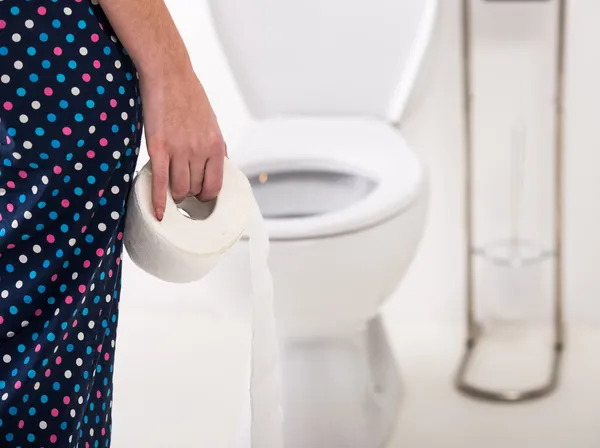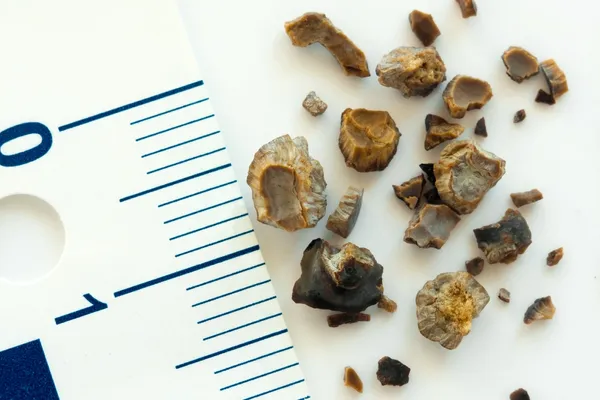You wake up in the middle of the night feverish, your lower back hurts, and your abdomen is painfully swollen and tender. What’s even worse is that when you get up to use the bathroom, it’s so painful to urinate that you think you might die.
You, my friend, are likely one in 10-percent of North Americans with a kidney stone.
This excruciating condition occurs when a small speck of calcium (from your urine) forms in the kidney or the ureter (the passageway from your kidney to your bladder) and more minerals stick to it to form a tiny stone that many patients describe as so terrible, it’s “more agonizing than giving birth.”
If you have a kidney stone, you’ll likely know it soon enough. However, there are several early warning signs that can alert you to the formation of a stone early on…
1. Frequent Urination
One of the earliest and most common warning signs that you may have kidney stones is a sudden and unexplained increase in the frequency and urgency of urination. You will notice an intense need to urinate, even when you haven’t been drinking unusually large quantities of fluid.
2. Spreading Back Pain
A localized, nondescript form of pain often accompanies kidney stones from their earliest stages. Patients usually report that this pain begins in their sides and back, just below the rib cage where the kidneys are located. As the condition develops, the pain may travel from the lower abdomen down into your groin area and into your lower back, presenting in fluctuating waves of throbbing pain and general tenderness. These waves of pain can last anywhere from a few minutes to a few hours, depending on the size and location of the kidney stones.
Men with kidney stones may also find that the pain can migrate into their scrotum and testicles. Some of the symptoms of kidney stones may mimic certain sexually transmitted infections (STIs), especially pain in the genital region and painful urination. If you’re experiencing these symptoms, it’s important that you get a prompt and proper diagnosis as soon as possible.
3. Blood in Urine
In addition to more frequent urination and painful urination, you will likely notice changes in the color and consistency of your urine if you have kidney stones. Discoloration is one of the most notable of these changes; rather than being clear or yellow in color, your urine may range anywhere from pink or red to light or dark brown. As the kidney stones grow and block off your urethra, you may also begin to notice your urine tinged with small amounts of blood, a condition known as hematuria.
Blood gets into your urine when the kidney stone lodges itself in your urethra, scraping against your ureter or kidneys. If that sounds painful, that’s because it is this condition causes intense discomfort. The amount of pain you’re in is a good indicator of the size of the kidney stone; larger stones cause more intense pain, while smaller ones produce milder discomfort.
4. Nausea and Vomiting
Some people suffering from kidney stones report that they feel nauseous. In some cases, this nausea can become so severe that it will cause vomiting, which can, in turn, cause a host of other complications ranging from nutritional deficits to dehydration. One of the causes of vomiting is the intense pain that you will experience if you pass a kidney stone. Some people find the pain so intense that they throw up.
Another reason vomiting occurs is that the kidneys play a very important role in eliminating toxins and wastes from your body. Kidney stones impair the organ’s proper function, meaning that there are likely to be elevated levels of toxins and impurities in your stomach contents and bloodstream. Your body wants to get rid of these toxins, but if your kidney function is impaired, vomiting may be the only other way to expel them.
5. Pungent Smelling Urine
Patients suffering from kidney stones will also notice that along with discoloration, urine also appears cloudy and may give off a pungent and foul odor. While it is normal for urine to give off a slightly bitter smell from time to time, there’s no mistaking or missing the kind of sharp stench that can occur if you have kidney stones. This odor occurs due to the presence of a heavy concentration of hard chemicals and toxins in the urine.
As mentioned, the kidneys play an important role in removing toxins and chemical impurities from your body. Many of these substances are eliminated through the urine, but with your kidney’s normal functioning impaired, these toxins can linger and actually crystallize in the body. Those crystallized toxins are what the kidney stone is made of, and when they are released in your urine, you’ll smell the difference.
6. Fever and Chills
It is unusual for kidney stones to go untreated, since the symptoms they cause produce such high levels of pain and discomfort. However, in a small minority of cases, the kidney stone remains relatively small and doesn’t cause intense symptoms. In such cases, the kidney stone is still causing problems in the urinary tract, scratching up against surfaces and creating small internal wounds that could become infected.
Kidney stones bring a heightened risk of urinary tract infection (UTI), which can, in turn, cause a fever and chills. Other symptoms of UTIs include abdominal or pelvic pain and abnormalities in the color, frequency, and consistency of urine. The fever can reach high levels, potentially putting the patient in danger. You should always consult a doctor if you have a high fever, especially if it’s accompanied by chills and isn’t being caused by a known factor, such as a cold or flu.
7. Kidney and Abdominal Swelling
If the kidney stones reach a large size, they can effectively block the normal flow of urine, preventing urine from traveling through the urethra on its way out of the body. This creates a backlog of urine, which gives rise to a whole host of potentially serious symptoms. One of the earliest signs that things are reaching this critical stage is intensely painful swelling of the kidneys.
You have two kidneys, one on either side of your body. They are located beneath your diaphragm, near your lower back. If they become painfully swollen, you will notice swelling and inflammation in this area and in surrounding regions of the abdomen and groin. These areas will be very painful to the touch, and you should seek immediate medical attention if you develop these symptoms. Should this symptom go untreated, you risk having your body go into septic shock as it becomes overwhelmed by the toxins in the urine it can’t get rid of.
8. Sudden and Severe Pain
Reader’s Digest talked to Douglas Propp, MD, Medical Director and Chair of Emergency Medicine at Advocate Lutheran General Hospital in Park Ridge, Illinois, about the warning signs of kidney stones. He listed sudden and severe pain as one of the main warning signs. This is the symptom that gets them in the emergency room in the first place, before they even realize what they’re suffering from. “Pain associated with kidney stones often comes on suddenly and is sometimes described as excruciating as the pain associated with labor,” says Dr. Propp.
The pain is so bad it often comes with no available relief, no matter what position they are in. It can even wake someone from their sleep. It can feel similar to a stomach ache or a back strain that starts in the upper back. The pain might move down into their lower back as the kidney stone moves closer to the bladder. Reader’s Digest also notes that the size of a kidney stone doesn’t have much impact on the severity of pain, but they’re usually about five millimeters in length. Even the smallest of stones can cause an unnerving amount of pain.
9. Urinate in Small Amounts
As we previously mentioned, kidney stones come in all different shapes and sizes. While the average kidney stone is five millimeters in length, there have been ones that are bigger. Someone who’s suffering from a larger kidney stone might find it stuck in their ureter. Healthline points out that this could cause even more problems, such as slowing or stopping the flow of urine.
If you find that you are unable to urinate or that it’s only happening in small amounts at a time, go see a doctor immediately.
10. Painful Urination
When you do produce a normal volume of urine, you may find that the act of urinating causes intense pain. This happens if the kidney stone is moving from the bladder into the urethra. Sharp, searing pain will occur, and you may also develop a UTI as the kidney stone migrates further. By the time things reach this point, chances are you’ll already have gone to see your doctor; if you haven’t, book an appointment.
11. Unable to Sit Still
This one isn’t all that surprising, especially considering how painful a kidney stone can be! Someone who’s in an excruciating amount of pain will find it hard to remain in one place even though it probably won’t do any good for their symptoms! The National Library of Medicine says an episode of kidney stone pain can last anywhere from 20 to 60 minutes.
Health.com talked to Margaret Pearle, MD, PhD, Professor and Vice Chair of Urology at UT Southwestern Medical Center in Dallas who said, “People are not sitting still with stones. They’re moving around to try to find a more comfortable position.”
12. Flu-Like Symptoms
We’ve already listed a lot of the symptoms that are related to this, but in general, kidney stones can cause what’s described as flu-like symptoms, especially if the patient develops an infection. According to LiveStrong, sometimes an infection will develop if a kidney stone gets stuck in the urinary tract. This infection will cause “fever, chills, and fatigue. Severe back or abdominal pain caused by kidney stones can lead to stomach upset in patients.” Of course, an upset stomach also leads to nausea or vomiting. Don’t go assuming you’ve got a kidney stone every time you’ve come down with the flu! Check for other related symptoms and as always, be sure to consult a doctor.
13. Risk Factors
Anyone can develop kidney stones, but its occurrence is two times more common in men than women. In fact, more than one of every eight American men will experience kidney stones at some point in their life.
Aside from sex, there are other risk factors associated with kidney stones. Some of them include:
- Family history
- Caucaisan race
- Middle age
- Low fluid intake
- Diets with high sodium, high animal protein, or high sugar intake
- Use of calcium supplements
- Diabetes
- Coronary artery disease
- Obesity
- Certain urinary tract infections of abnormalities
Talk to your doctor about the various risk factors for kidney stones and find out if you carry a higher chance of developing them.
14. Children Can Get Kidney Stones
Adults between the ages of 20 and 50 carry the most risk of developing a kidney stone. But did you know it’s possible for children to develop them, too? The causes and symptoms are the same as adults.The pain can last for short or long periods of time, and it may come and go in waves.
A child’s chance of developing kidney stones are higher when they cannot move for a long period of time, like after surgery, for example. You can prevent your child from getting kidney stones by controlling their sodium intake, getting the recommended amount of calcium from foods, limiting animal protein, and avoiding certain foods to reduce oxalate in the urine.
15. Diagnosing Kidney Stones
After sharing your symptoms with a doctor, the next steps are to go through testing. You might get a blood test that will show whether there is too much calcium or uric acid in your blood, which is a known cause of kidney stones.
A urine test can also show whether you’re excreting too many stone-forming minerals or too few stone-preventing substances. This process may be performed over a couple days. In some cases, doctors may order an imaging test to get a visual of stones in your urinary tract.
16. Treatment For Small Stones
For small kidney stones, doctors will try to let the stone pass in your urine. This can be really uncomfortable for the patient but is preferable, especially if it’s managed with medications for pain relief and muscle relaxers. Pain control will be the main form of treatment to make patients more comfortable until the stone passes through their system.
17. Treatment for Large Stones
Not all kidney stones can pass naturally through the urinary tract. Some can be too big, which can block the flow of urine. Doctors can break down the stones either by using sound waves, or inserting a tube with a camera through the urethra and using tools. This will allow the patient to later pass the smaller pieces through their urine. Alternatively, other patients may require surgery to directly remove stones from the kidney.
18. Possible Complications
Smaller kidney stones are less likely to cause complications, but bigger ones do come with increased risk. Large kidney stones have the potential to cause bleeding or kidney damage. They could also cause ongoing urinary tract infections that will require you to get more treatment. If a patient needs surgery to treat stones, that comes with its own set of risks and potential complications that should be discussed with your doctor.
19. Preventing Kidney Stones
Understanding the risk factors may help lower your chances of getting kidney stones. Some things you can do include limiting your meat intake, staying hydrated, and understanding your family history. You should also find out from your doctor whether a pre-existing condition you have increases your odds of getting kidney stones.
If you have kidney stones, Mayo Clinic explains how your doctor may analyse the stones you pass. Labs tests can examine the stones caught from your urine to determine the makeup of your kidney stones. This information can help doctors understand the cause of your kidney stones and create a medical plan to prevent more from developing in the future.
20. When to See a Doctor
Kidney stones are a painful and common condition that Americans experience everyday. As soon as you’re experiencing symptoms, you should see a doctor. They might be able to help manage your pain until the stones pass. Doctors will also examine whether or not the stones need to be removed in surgery to prevent further complications.























